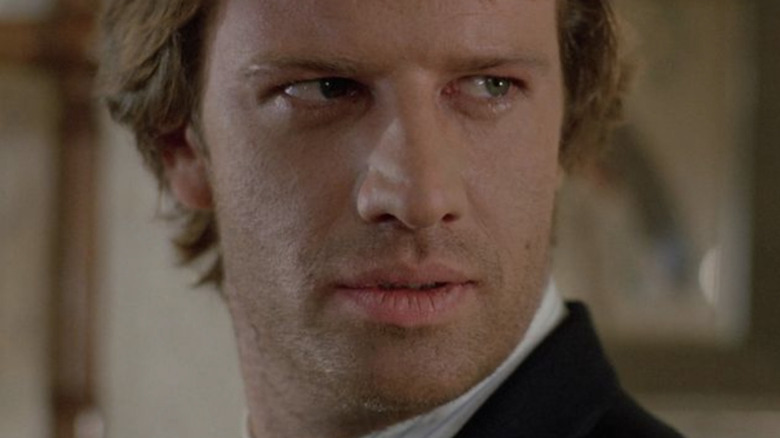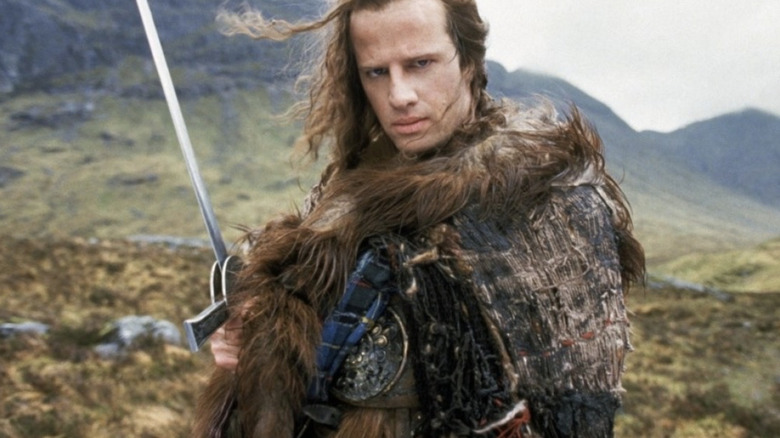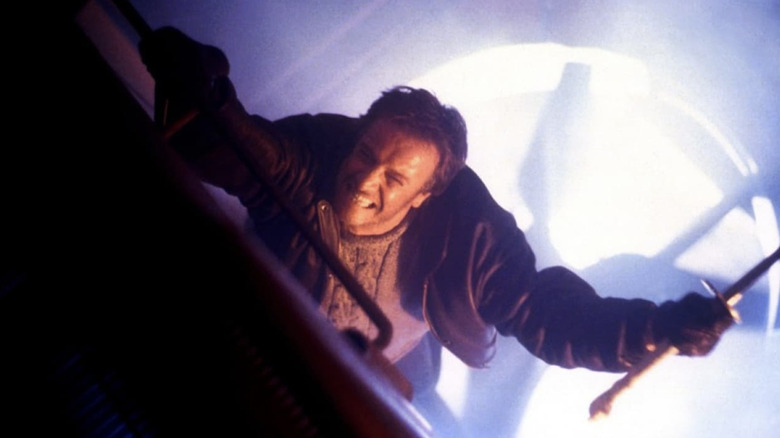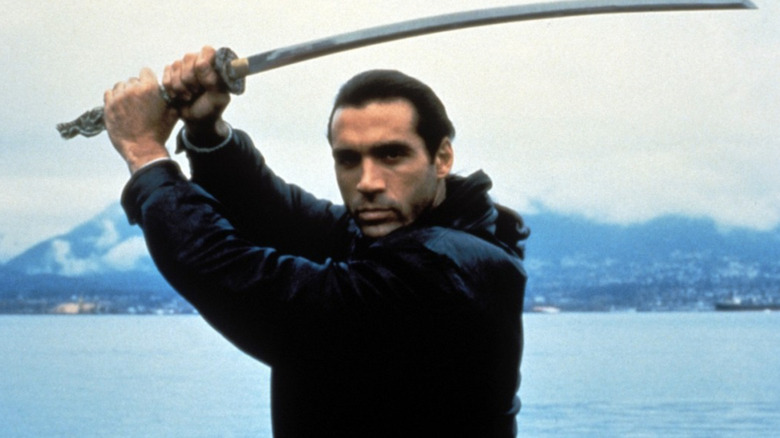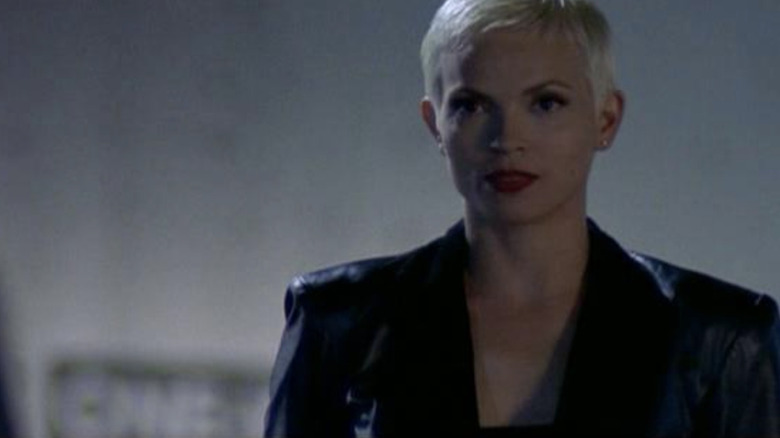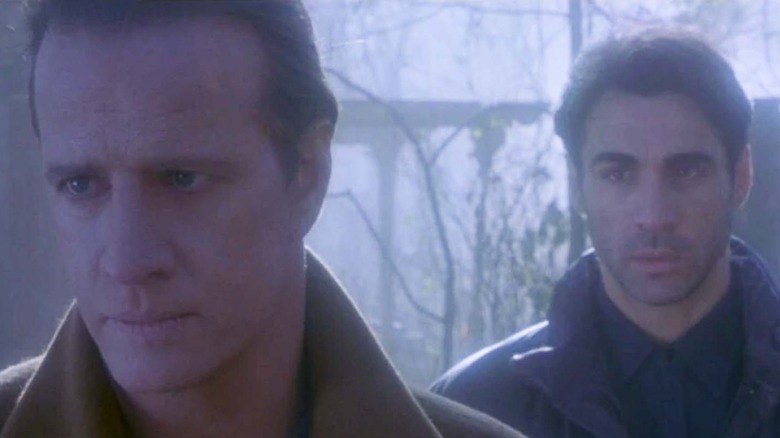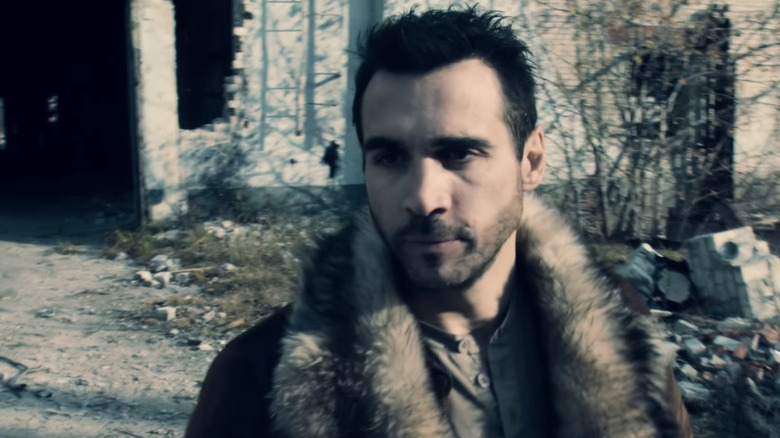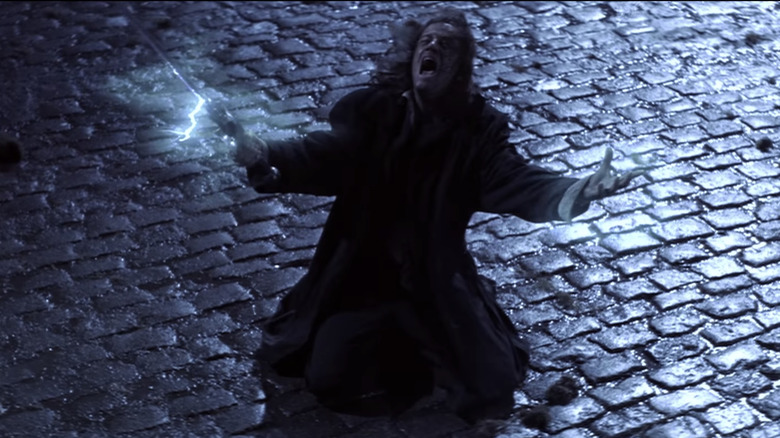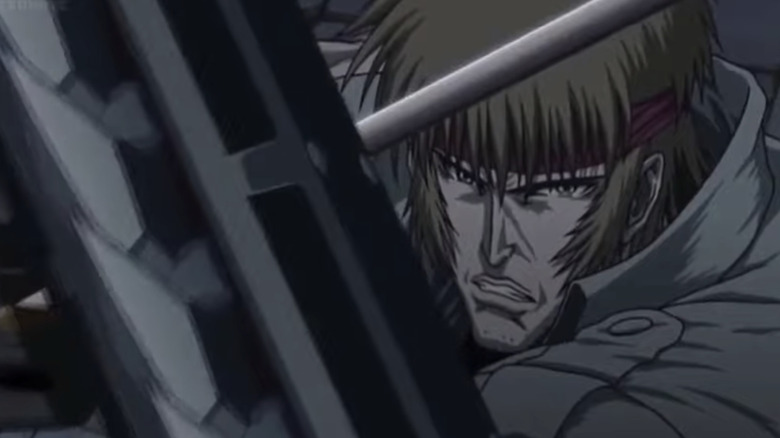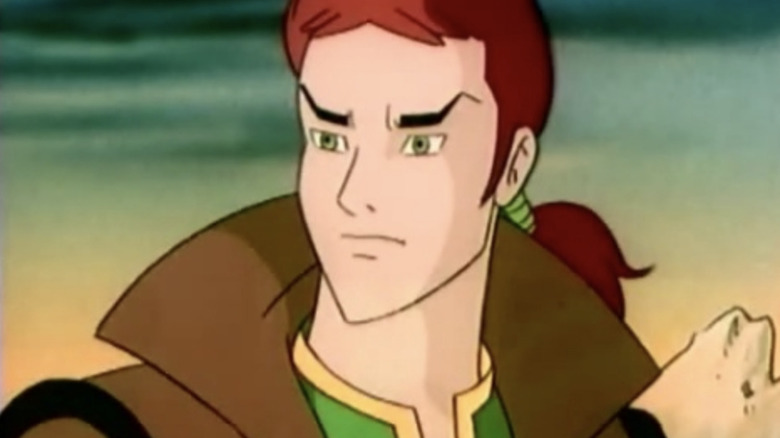This Is The Correct Order In Which To Watch The Highlander Franchise
"There can be only one!" Of all the action-fantasy franchises out there, few are more convoluted — or have as devoted a cult following — as the "Highlander" series. Beginning in 1986 with the original film starring Christopher Lambert as the immortal warrior Connor MacLeod, the saga was off to a terrific start. With plenty of epic battles, a vast mythology, and a stellar cast (including Sean Connery), there was nothing stopping "Highlander" from becoming a bigger hit ... except for a few sub-par sequels. It wouldn't be until 1992 that the series would find new life in "Highlander: The Series," which followed Connor's own clansman and immortal apprentice Duncan MacLeod (played by Adrian Paul), as he fought in the Game that would decide the fate of humanity.
While the "Highlander" franchise mostly focuses in on Connor and Duncan, other MacLeod clansmen have found their own spotlight through spin-off shows, animated productions, and comic books that take place across various timelines. If there's one thing that makes "Highlander" such a confusing story to follow, it's that just about every installment tends to ignore the last, with only the original film connecting the various timelines together. Nevertheless, Christopher Lambert and Adrian Paul's iconic MacLeods will forever be the faces of the "Highlander" series, and although Henry Cavill has been in talks to star in an eventual reboot, he'll never be able to fully replace our favorite Highlanders.
New to the clan? Join us as we discover the best way to embark on this journey.
Highlander (1986)
The original "Highlander" is largely considered the absolute best of the franchise, and for good reason. The film follows the thrillingly tragic story of the immortal wanderer Connor MacLeod (Christopher Lambert), as we learn all about his past as a Scottish Highlander, his journey to becoming the greatest of the Immortals, and about the Game itself — the centuries-long battle between Immortals where only one will survive and attain "the Prize," a "Quickening" that gives the winner the power of all the Immortals. As Connor battles his own demons — namely his arch nemesis the Kurgan (Clancy Brown) — he discovers that living is more than just survival, and that opening himself up to new love is just as important as destroying the forces of evil.
Lambert's work as Connor and Sean Connery's as Juan Sánchez-Villalobos Ramírez (the only character besides James Bond that Connery would play more than once, if you check his filmography) is some of their most engaging on screen, and their relationship would become legendary across the "Highlander" franchise. It may seem like your traditional immortal warrior origin story, but there are enough fantastical twists to take the story in some fresh directions. At the end of the day, "Highlander" is '80s fantasy at its peak, featuring excellent swordplay, a fascinating world, an epic Queen song, and well-constructed characters who represent the timeless battle between good and evil. In short, you must start here ... though, contrary to how the film ends, there are plenty more adventures to be had.
Highlander: III: The Sorcerer/The Final Dimension (1995)
No, you didn't read that wrong — the next "Highlander" film you need to watch after the original is 1994's third entry, "Highlander III: The Sorcerer," which was more widely known as "Highlander: The Final Dimension." In this installment, which completely ignores the events of "Highlander II," Connor MacLeod returns to face the Immortal illusionist Kane, who can use his magical abilities to make himself look like anybody. "The Final Dimension" was actually released during the third season of "Highlander: The Series" (more on that in a minute), but given that the show follows a different MacLeod, give this one a watch first.
Of course, Christopher Lambert returns as Connor MacLeod but with one crucial change from the ending of the original 1986 film: Connor didn't win the Game and attain the Prize, but instead only absorbed the power of the Kurgan. Here in "Highlander III," Connor is forced to face off against Kane to finally attain the Prize so that he might live a normal life as a mortal. If this feels like a retread of the original fantasy classic, then you'd be right, but out of the two theatrical sequels starring Christopher Lambert, "The Final Dimension" is the best and did wonders to promote "Highlander: The Series," which shares a similar (though not strict) continuity with the first and third "Highlander" films. Sadly, unlike the original film and television series, "Highlander III" didn't feature any music by Queen.
Highlander: The Series (1992-1998)
"Highlander: The Series" sparked the initial debate among "Highlander" fans as to whether they preferred Connor MacLeod or his clansman and apprentice Duncan MacLeod (played by Adrian Paul), which feels vaguely similar to the classic "Star Trek" debate over Captains Kirk or Picard. Regardless, Christopher Lambert appeared in the pilot episode, "The Gathering," to pull his friend Duncan back into the Game to defend the world, passing the torch (or sword) to his fellow clansman. Duncan accepted his mentor's call and returned to the Game to claim the Prize for good instead of evil, a battle he goes on to fight for years. "Highlander: The Series" is no doubt the favorite "Highlander" sequel of many, who quickly fell in love with the younger MacLeod.
Unlike Connor, Duncan MacLeod wasn't exactly a loner, and worked for six seasons alongside allies like Richie Ryan (Stan Kirsch), Joe Dawson (Jim Byrnes), Methos (Peter Wingfield), Amanda Darieux (Elizabeth Gracen), and Tessa Noël (Alexandra Vandernoot), to name a few. "The Series" was also set in the fictional city of Seacouver, Washington (a combination of Seattle and Vancouver, British Columbia, two of the series' key shooting locations), which gave Duncan and his crew a distinct base of operations before the series trotted around the globe. For many "Highlander" fans, Duncan MacLeod — not Connor — is the first Highlander to come to mind, proving that even if there are two of them, there can really only be one.
Highlander: The Raven (1998-1999)
The direct sequel/spin-off to "Highlander: The Series" is a bit less loved than its predecessor. Following Duncan MacLeod's on-again/off-again Immortal girlfriend and thief Amanda Darieux (played once again by Elizabeth Gracen), the series sets her on a path of redemption alongside ex-cop Nick Wolfe (Paul Johansson) who helps her on her quest. Unfortunately, like so many TV spin-offs of its era, "Highlander: The Raven" was doomed to fail from the start. While the series itself grapples with the same philosophical themes and conflicts as the rest of the franchise, the producers spent the entire final season of "Highlander: The Series" deciding which female character to spin-off with "The Raven" rather than writing the series with Amanda in mind. Sadly, Amanda and Nick hardly grow at all over the course of 22 episodes, making cancellation inevitable.
While every installment in the "Highlander" franchise involves some deep and dark tragedy, none exactly compare to the final episode of "Highlander: The Raven," aptly titled "Dead on Arrival." After a season of battling Immortals and catching criminals together, Nick is poisoned and set to die. Recognizing that Nick is an Immortal, Amanda kills him, only for him to resurrect unharmed. Instead of being grateful for this gift, Nick becomes enraged and leaves Amanda, and "The Raven," forever, ending the series with a dark question that would haunt the rest of the franchise: "What room is there for love, when there can be only one?" Feel free to skip this one if none of this sounds appealing.
The Methos Chronicles (2001)
Another spin-off from "Highlander: The Series," this one is a bit different due to the Flash animation that holds it together. "The Methos Chronicles" follows the Immortal Methos (with Peter Wingfield reprising his role from "The Series"), largely explore the character's origins from his time in Ancient Egypt. While "The Methos Chronicles" might've worked better as a live-action miniseries or even a comic book (the animation is terribly dated), this is what fans of Wingfield's character got, and they ended up loving it. While the series only lasted eight episodes, a few die-hard fans ended up producing eight more to round-out the story of their favorite Immortal (which can be watched in full on YouTube).
While "The Methos Chronicles" was technically released after "Highlander: Endgame" (which we'll get to), there's absolutely no reason you can't watch it beforehand. Again, these animated shorts are severely dated, with early web animation that you're more likely to laugh at than take seriously, but seeing how the episodes are only about a minute long each, they're pretty easy to sit through. If Methos ended up being one of your favorites on "Highlander: The Series," then you should at least give his "Chronicles" a good college try, especially since the story itself is pretty interesting. But if you really hate it, just go watch the "Reunion" short film that reunited Methos, Joe Dawson, and Amanda (from "The Raven") 10 years after the "Highlander" series finale — it's great!
Highlander: Endgame (2000)
After nearly a decade of waiting, and a few years after "Highlander: The Series" ended, Duncan and Connor MacLeod were finally reunited in "Highlander: Endgame," the sort of "series finale" to the entire "Highlander" saga. Effectively concluding the stories of both Connor and Duncan, "Endgame" was a made-for-television movie that actually delivered. Once again ignoring the end of the original 1986 film, the entirety of "Highlander II," and the inconvenient parts of "The Final Dimension," this film marks the fifth and final appearance of Christopher Lambert as the original Highlander himself. In an emotionally charged, high-stakes, 90-minute adventure, the MacLeods are forced to confront a dangerous new enemy named Jacob Kell (Bruce Payne), who threatens to win the Game and claim the Prize for his own.
To stop Kell from potentially destroying the universe, and to keep the Prize from falling into the wrong hands, the MacLeods are forced to make a fateful choice that will prove once and for all that there can truly be only one Highlander ... even in a film with two. The final scene between Duncan and Connor is pretty memorable, and highly emotional, and if you're a fan of this franchise you won't walk away without misty eyes. No doubt, "Highlander: Endgame" works well as an official end to both Christopher Lambert's "Highlander" films as well as Adrian Paul's work on "The Series," making us wish that they hadn't continued the franchise any further ... at least without a strict reboot.
Highlander: The Source (2007)
If you really feel the need to keep watching the story of Duncan MacLeod after "Highlander: Endgame," there is, in fact, another direct-to-video movie that continues (and seemingly concludes, again) Duncan's saga as an Immortal called "Highlander: The Source." Set in the unspecified post-apocalyptic near future, Earth has been plunged into chaos. As a group of Immortals attempt to locate the Source of Immortality, the villainous Guardian of the Source (Cristian Solimeno) arrives to fight back. Only with the help of the Highlander, Duncan MacLeod himself (once more played by Adrian Paul), can the Immortals claim the Prize and save the world ... at least, that's how the film was marketed. In reality, "The Source" is actually a very strange story about Duncan, his ex-wife Anna (Thekla Reuten), and their inability to have children.
Many fans abhor "The Source," and it seems at least some people involved with the franchise agree. According to the fansite HighlanderEndgame.com, producer David Abramowitz allegedly commented at a convention that the movie was simply Duncan's "bad dream." There was never another "Highlander" sequel made after this, though there were plenty of other "Highlander: The Series" media projects that would either contradict or ignore the events of this fifth and final film, including an audio drama featuring returning cast members and the "Highlander: Reunion" short film produced for the web that brought back fan-favorite characters (aside from Duncan, of course). For many, the "Highlander: The Series" canon ends with "Endgame," with "The Source" being the black sheep that everyone tends to ignore.
Highlander II: The Quickening - Renegade Version (1991, 1995)
If you're interested in some more black sheep, you should also check out the second "Highlander" feature film, "Highlander II: The Quickening." In this vastly hated 1991 sequel (check out its rare 0% critic score on Rotten Tomatoes), Christopher Lambert and Sean Connery return as Connor MacLeod and Juan Sánchez-Villalobos Ramírez, respectively. "The Quickening" retcons a ton of the original "Highlander" lore by explaining that the Immortals actually come from the alien planet Zeist, while also resurrecting Ramírez and changing what a "Quickening" is in the first place. In short, "Highlander II" just so happens to be one of the worst films ever made. Having said that, there is a slightly better version that makes a lot more sense if you're interested in further adventures with Connor MacLeod.
Per Den of Geek, director Russell Mulcahy (who hated the theatrical cut of "Highlander II" so much he requested his name be taken off of it) prepared the "Renegade Version" for release a few years later in 1995. By recutting the film and restoring some scenes that had been cut, this home video edit changes the Immortals back to human beings (albeit, from a more advanced age in the distant past) and actually does a decent job of making the entire premise a bit easier to swallow. Like "The Source," the second "Highlander" is set in a horrid future (2024 if you can believe it) when the ozone layer has nearly been destroyed. Connor does his best to save the world, win the Prize, and finally find his happy ending. It's not as bad as "The Source" (no "Highlander" film is), but "The Final Dimension" and "Endgame" are undoubtedly better sequels that honor Connor MacLeod and his legacy. Either version of "The Quickening" is for diehards only.
Highlander: The Search for Vengeance (2007)
If you thought the MacLeod legacy would end with Connor and Duncan, then you'd be dead wrong. "Highlander: The Search for Vengeance" was an anime film released around the same time as "Highlander: The Source," but don't let that discourage you – this one is actually really good. Set in the year 2187, the film follows Colin MacLeod (voiced by Alistair Abell) as he wanders this distant future hoping to restore balance and defeat the oppressive evil that has kept the world in darkness for centuries. Whether "The Search for Vengeance" takes place in "The Series" canon or in its own world entirely is unclear, but the film was written by series producer David Abramowitz and directed by "Animatrix" and "Ninja Scroll" director Yoshiaki Kawajiri.
With epic visuals, a compelling story, and characters who feel like three-dimensional people despite being animated in 2D. "Highlander: The Search for Vengeance" is not one to sleep on, even if it may not contribute to the canon. Aside from the original 1986 feature film, this anime production is the most well-received "Highlander" film out there by fans and critics alike, and won't fail to entertain if you're a fan of the series. It might still entertain even if you aren't. Colin MacLeod is an excellent protagonist who feels like the best parts of Connor and Duncan while still being his own distinct character — complete with super speed and strength — in an even more distinct world.
Highlander: The Animated Series (1994-1996)
Like just about every hit 1980s movie — including plenty of violent, R-rated action flicks — "Highlander" became an animated series marketed to a younger crowd. Set in the post-apocalyptic 27th century, "Highlander: The Animated Series" follows Quentin MacLeod (Miklos Perlus) as he's trained by his mentor, an alternate version of Ramírez (voiced by Benedict Campbell), after learning that he is the fulfillment of an ancient prophecy by Connor MacLeod that there would be a "new Immortal" who would rise up against the evil Kortan (Lawrence Bayne) and restore the world to its former glory. "Highlander: The Animated Series" ran for two seasons totaling 40 episodes in the early 1990s, and even spawned an Atari video game, "Highlander: The Last of the MacLeods."
The animated series itself was a classic Saturday morning cartoon that thrived because it distanced itself from the rest of the franchise. Rather than rely on Connor MacLeod, they killed him off long before the events of the series, allowing Quentin to thrive as his own character and explore this new world that we've never seen before. Kortan was also an excellent antagonist, and the series finale features an epic clash between Quentin and the dark Immortal that seemed to end his reign of terror forever. Though we're unlikely to ever adventure with Quentin MacLeod again, his hero's journey is one that's worth revisiting — and although it isn't terribly important to the overall franchise, it's a piece of "Highlander" history that's worth watching.
